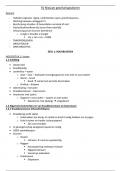SOLUTION MANUAL FOR
Financial Management for Public, Health, and Not-for-Profit Organizations Seventh
Edition by Steven A. Finkler
TE
ST
SO
LU
TI
O
N
FULL TEST BANK!!!
,Chapter 3: Additional Budgeting Concepts 3-2
INTRODUCTION
Chapter 1 TO
FINANCIAL
MANAGEMENT
TE
Questions for Discussion
1-1. Financial management is the subset of management that focuses on generating financial information
that can improve decisions. The decisions are oriented toward achieving the various goals of the
organization while maintaining a satisfactory financial situation. Financial management encompasses
the broad areas of accounting and finance.
ST
1-2. In proprietary, or for-profit, organizations, an underlying goal is to maximize the wealth of the
owners of the organization.
1-3. In public service organizations, decisions are oriented toward achieving the various goals of the
organization while maintaining a satisfactory financial situation.
SO
1-4. Accounting is a system for keeping track of the financial status of an organization and the financial
results of its activities. It has often been referred to as the language of business. The vocabulary
used by accounting is the language of nonbusiness organizations as well.
1-5. Accounting is subdivided into two major areas: managerial accounting and financial accounting.
LU
Managerial accounting relates to generating any financial information that managers can use to
improve the future results of the organization. This includes techniques designed to generate any
financial data that might help managers make more effective decisions. Major aspects of managerial
accounting relate to making financial plans for the organization, implementing those plans, and then
working to ensure that the plans are achieved. Some examples of managerial accounting include
preparing annual operating budgets, generating information for use in making major investment
TI
decisions, and providing the data needed to decide whether to buy or lease a major piece of
equipment. Financial accounting provides retrospective information. As events that have financial
implications occur they are recorded by the financial accounting system. From time to time (usually
monthly, quarterly, or annually), the recorded data are summarized and reported to interested users.
O
The users include both internal managers and people outside the organization. Those outsiders
include those who have lent or might lend money to the organization (creditors), those who might
sell things to the organization (called suppliers or vendors), and other interested parties. These
N
interested parties may include those with a particular interest in public service organizations, such as
regulators, legislators, and citizens. Financial reports provide information on the financial status of
the organization at a specific point in time, as well as reporting the past results of the organization‘s
operations (i.e., how well it has done from a financial viewpoint).
,1-6. Finance focuses on the alternative sources and uses of the organization‘s financial resources.
Obtaining funds when needed from appropriate sources and the deployment of resources within the
organization fall under this heading. In addition, finance involves the financial markets (such as
stock and bond markets) that provide a means to generating funds for organizations.
1-7. Yes. Achieving the goals of the organization requires financial planning. Financial management
TE
provides information for managers to use in making their decisions. It helps managers by
providing information on the likely financial impact of each proposed alternative. It also provides
information about financial stability, efficiency, and effectiveness.
1-8. Clearly, we might expect some public service organizations that are proprietary, such as some
hospitals, to earn profits. But what about other public service organizations such as charities? They
ST
should make a profit as well. Profits provide a safety margin against unexpected costs, provide
resources to replace buildings and equipment, and to expand and improve services.
1-9. Federal government (see text Figure 1-1)
◼ Individual income taxes
◼ Social insurance taxes
SO
◼ Corporate income tax
State and local government (see text Figure 1-4)
◼ Sales and gross receipts tax
◼ Federal government
◼ Property taxes
LU
◼ Individual income taxes
Health sector (see text Figure 1-6)
◼ Private insurance
◼ Medicare
◼ Medicaid
TI
◼ Other government programs
Not-for-profit sector (see text)
◼ Private payments for goods and services
O
◼ Government payments for goods and services
◼ Donations
1-10. Federal government spending exceeded $6 trillion in 2020 and state and local government spending
N
was more than $3 trillion in 2018. In contrast, the GDP was $21 trillion in 2020. For more up to
date information, examine the statistical tables of the most recent Economic Report of the
President, which is available online.
1-11. The reported surplus includes both on and off budget items. Social security taxes represent an off
budget item that until recently raised more revenue than was spent on social security payments.
, TE
ST
SO
LU
TI
O
N





